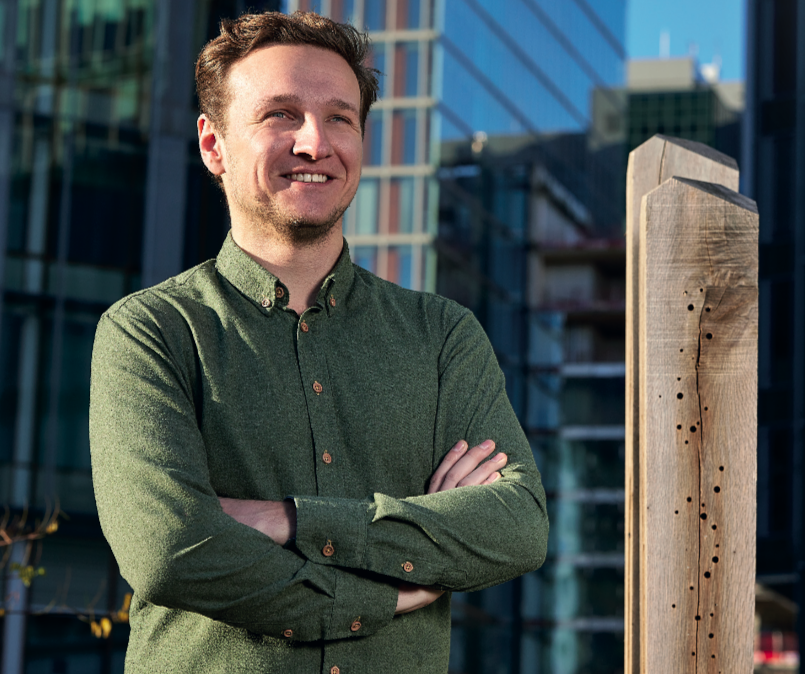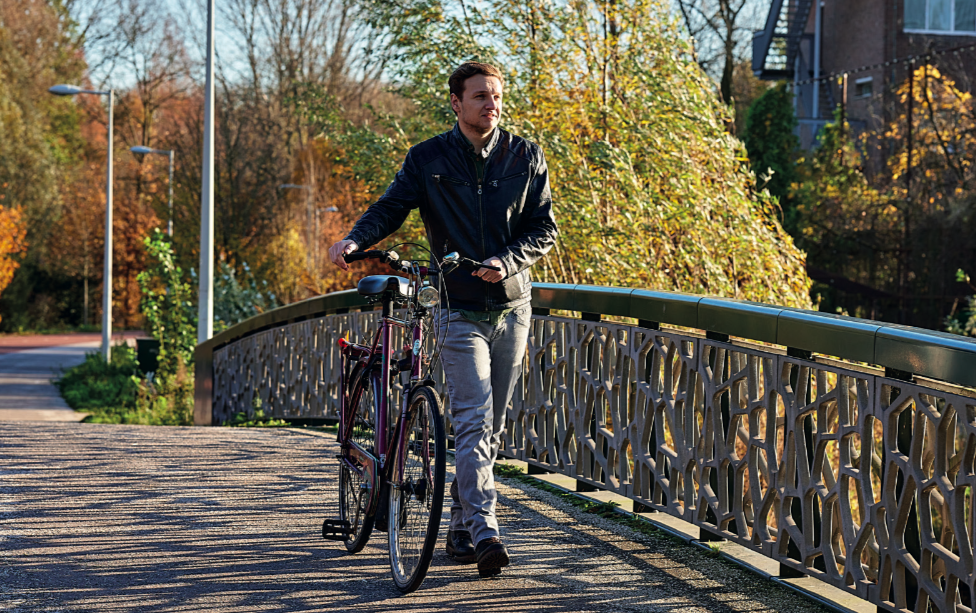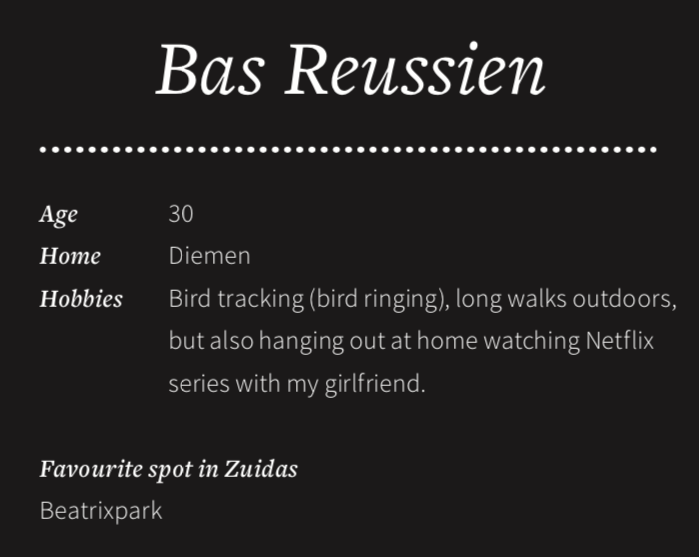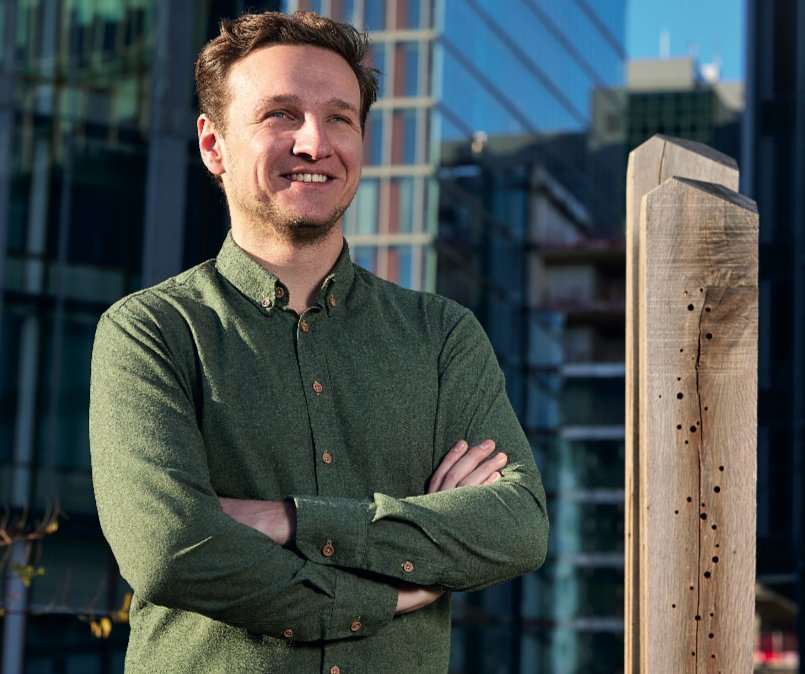Interview Bas Reussien, Zuidas biodiversity adviser for the City of Amsterdam
'Zuidas isn't sustainable enough yet, but we're making progress'
Sustainability is a word you hear everywhere these days. But how can a place like Zuidas, with all its bricks and mortar, become sustainable and create enough biodiversity? Hello Zuidas talked to Bas Reussien, Zuidas biodiversity adviser for the City of Amsterdam. He answered this question and explained his role in Zuidas.

What does sustainability mean to you?
‘Sustainability is a broad concept. Most people immediately associate it with solar panels, windmills and plastic recycling. For me sustainability is fundamentally about preserving of what’s good, while at the same time creating something long-lasting and self-perpetuating, so we humans don’t always have to intervene. That’s also how I define sustainability in my job: to create an ecosystem in Zuidas for animal and plant species that are native to this area and can survive here.’
Can you name some examples?
‘We still have quite a few places in Zuidas with bats. They’re a great species for keeping insect populations in check. They eat thousands of mosquitoes nightly, so they don’t bother us. And we don’t need to take as many measures to combat mosquitoes as a pest. Nature maintains her own balance. By helping bats, they help us in turn. The same goes for common swifts, that fly over from Africa every spring to nest in cracks of old buildings. But due to stringent sustainability requirements for building insulation, there are fewer suitable places left for them. We’re helping these swifts find nesting spots by installing nesting boxes on many new buildings.’
Can you tell us more about your job as biodiversity adviser?
'My job straddles multiple tasks, but I spend a big chunk of my time on various projects in Zuidas. I make sure none of them go against nature conservation law. With any kind of spatial development, you also need to examine its effects on protected animal and plant species. Bats that feed along Boelegracht have to be able to continue doing so. The municipality and Zuidas want to preserve and bolster these sites. I help projects to arrange for studies so they can obtain the permits they need. If research shows a certain development will negatively impact a protected species, I help prepare a plan to minimize and compensate that. Together with my colleagues I also draft requirements on nature-inclusive designs for property developers, like adding nesting boxes and planting. That way, all these projects can contribute to a sustainable ecosystem. In my job I’m actively involved with that, and fortunately designers are also starting to approach me directly to get my input on their plans for public spaces at an early stage, so we don’t have to backtrack later.’
Two new apartment blocks are going up in Beatrixpark. What are the requirements there?
‘The standars are very high. Take the lighting, where I’m trying to require the least possible amount of reflection on the water. In their plans, the designers will have to figure out how to achieve that. Keeping some areas of total darkness is vital for bats, especially over the water. My time and energy also go into mapping biodiversity in Zuidas so we know up front to watch for and we’ll be able to assess the results afterwards.’

Is sustainability being picked up by the construction industry?
‘Absolutely. Fortunately, lots of developers have really great ideas. But in the end they often still opt for things like solar panels to meet standards, despite starting out with ambitious plans for, say, green roofs. We’re hoping to challenge developers to explore and come up with new ideas. An example of which is The Puls, a new building with an angled strip of solar panels running above the windows so that space on the roof – on the ninth floor – can be turned into a mini forest. That’s fantastic.’
How does your assistance work?
‘For new parcels to be issued we draw up a building envelope covering all policy rules and our requirements and wishes on all aspects like parking, lighting, energy use, building heights and sustainability. We also ask developers to think from the outset about how urban wildlife might make use of the building, to make the building a genuine link in the local ecosystem. We evaluate the plans from time to time and add our input. I look at the quality of the green spaces and wildlife measures, and at its underlying philosophy. Nature-inclusive construction is different for each project, and I add municipal and district guidelines to the mix. In Zuidas we’re also incrementally raising the sustainability bar a little higher than for the rest of Amsterdam.’
Is Zuidas sufficiently sustainable? ‘
No, we can do a lot better, although I do think we’ve made good progress. My job and that of landscaping and tree advisers was the result of the designers’ ambition to be green, biodiverse and sustainable in their work. They needed help with that. That’s what brought me here, a couple years ago. Developing new buildings takes years, so the requirements and wishes I’ve set for biodiversity will be unfolding in the years to come. I’m confident they’ll positively impact the Zuidas ecosystem.’
There are strict requirements for all new construction, but how does it work with old buildings?
‘Although we can’t set high sustainability standards for old buildings, there’s still plenty that can be done. Adding green roof and façade systems, for instance, like sedum underneath solar panels, or more nesting boxes for birds. Sedum are tiny succulents that can do well on rooftops, that are often hot and dry. They’re low-maintenance but contribute to the ecosystem, as they still produce lots of nectar and pollen. And every additional nesting box counts, every plant on a roof counts, so if we all do that, we’ll create an ecosystem in which we all want to live and work.’
What more would you like to accomplish in Zuidas?
‘Zuidas’ image now is of a concrete jungle populated only by business- types, and not so much a green space with nature. I hope we can work towards making it a place people see as a beautiful green setting that is pleasant to live in, and where it’s nice to stroll round during lunch breaks. Biodiversity has to become a standard part of all property development, so that in ten years’ time we can welcome back animal species that were long gone, bringing house sparrows and swifts back, and that our efforts will have really made a difference. We’ve got the right impetus and mindset now, so let’s use it!’

